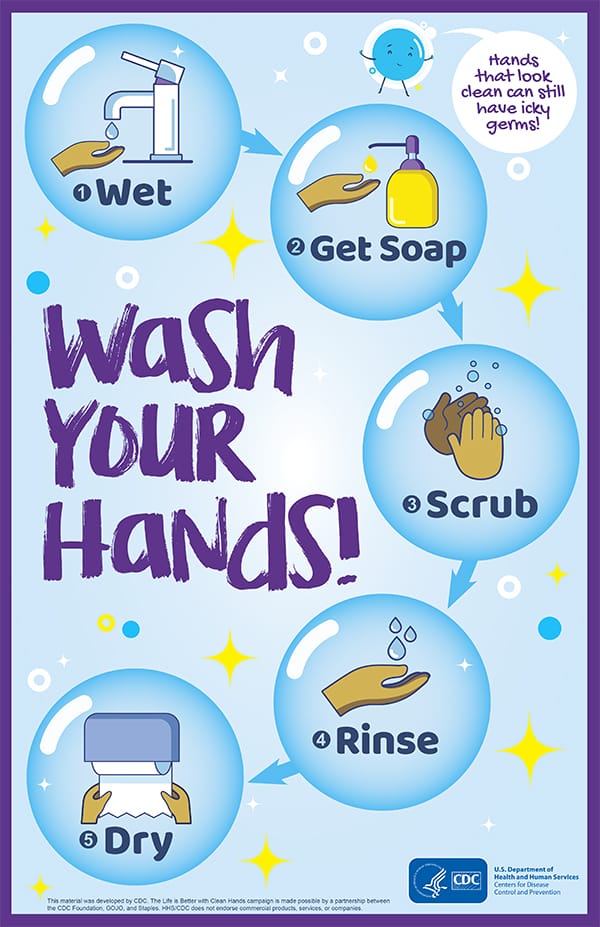It seems surreal: Twenty seconds of handwashing with plain soap and water are powerful enough to destroy microscopic coronavirus particles and help prevent the spread of the disease to yourself and others.
But the science is real. Thanks to their molecular makeups, soap and water, combined with regular handwashing, can kill the coronavirus and other germs.
While coronavirus news changes minute-to-minute, health organizations around the world continue to stress the importance of practicing good hygiene — including frequent, thorough handwashing — for children, teens and adults.
Experts believe the coronavirus primarily spreads through respiratory droplets when someone sneezes or coughs. A recent study in the New England Journal of Medicine shows that coronavirus can linger in the air and survive on some surfaces. If someone touches a contaminated surface and then touches their eyes, mouth or nose, they may contract the virus.
That’s why frequent handwashing is key. Soap, water and thorough handwashing rid hands of the virus, explains Bryan Dickinson, PhD, associate professor of chemistry at the University of Chicago.
“Think about how soap can take grease or oil stains off your clothes, make them dissolve and wash away,” he says. “This is because soaps are amphiphilic, meaning they can interact both with water and lipid phases of solutions. It’s the same idea.”
The coronavirus, Dickinson says, has a shell-like structure that soap is able to penetrate. The virus particles are enclosed by fatty lipids, which the soap molecules can easily tear apart.
“They break apart the noncovalent bonds between the lipids, rupturing the virus particle and destroying it,” Dickinson says. “The soap molecules dissolve the virus shell, and the rest of the viral material is washed away.”
How to wash your hands
Handwashing needs to last at least 20 seconds and include the fronts and backs of hands, wrists, nails and in between your fingers. The water does not need to be hot to be effective; cold water works too, according to the Centers for Disease Control and Prevention (CDC).
The CDC recommends handwashing at these key times:
- Before, during and after preparing food.
- Before eating food.
- Before and after caring for someone who is sick with vomiting or diarrhea.
- Before and after treating a cut or wound.
- After using the toilet.
- After changing diapers or cleaning up a child who has used the toilet.
- After blowing your nose, coughing or sneezing.
- After touching an animal, animal feed or animal waste.
- After handling pet food or pet treats.
- After touching garbage.
Drying your hands after washing them is also important, because germs can transfer more easily to and from wet hands, the CDC says.
Constant handwashing can leave skin dry and cracked. Those cracks leave you vulnerable to germs. To help prevent irritation, wash hands with a gentle soap and lukewarm — not hot — water, says Jill Cotseones, DO, a dermatologist at Northwestern Medicine Central DuPage Hospital.
“By changing your hand soap to a gentle, fragrance-free, formaldehyde-free cleanser, you are significantly decreasing your risk for irritation. Fragrance- and formaldehyde-containing products are frequent sources of allergic reactions that can also lead to flares of hand eczema,” Cotseones says.
She recommends that people moisturize their hands with a hand cream that contains petrolatum or glycerin. Moisturizers should also be gentle and fragrance-free. Ingredients like glycerin and petrolatum, she says, “restore the skin barrier and soothe dry, cracked hands.”
An approach for all ages
Good hygiene is, of course, important for people of all ages.
Chicagoans Heather and Tyson Roan, the parents of three young daughters, have experimented with different songs to help their children spend enough time washing their hands.
“We heard on the news to sing the ‘Happy Birthday’ song twice. That led to discussion as to how fast they should sing the song. One daughter was rushing through at lightning speed, which wasn’t adding up to the 20 seconds,” Heather says.
Although their oldest daughters are now 8 and 10 years old, they’ve revisited a song they learned in preschool, set to the tune of “Frere Jacques.”
That song’s lyrics: “Tops and bottoms, tops and bottoms, in between, in between. Then we wash our thumbs. Then we wash our thumbs. Now we’re clean. Now we’re clean.”
For a fun approach, make a handwashing poster with the lyrics to your favorite song at washyourlyrics.com.
And keep in mind that if soap and water are not immediately available — such as after touching a gas pump — hand sanitizers with at least 60% alcohol are a good backup. Products with lesser amounts of alcohol are not as effective at killing germs, according to the CDC.
To effectively use hand sanitizer, read the label to learn the correct amount to apply, and then apply the product to the palm of one hand, the CDC says. Rub all over the surface of your hands — front and back — until they are dry.














